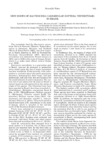Por favor, use este identificador para citar o enlazar este ítem:
http://www.alice.cnptia.embrapa.br/alice/handle/doc/989621Registro completo de metadatos
| Campo DC | Valor | Lengua/Idioma |
|---|---|---|
| dc.contributor.author | LEMOS, L. do N. | pt_BR |
| dc.contributor.author | ADAIME, R. | pt_BR |
| dc.contributor.author | JESUS-BARROS, C. R. de | pt_BR |
| dc.date.accessioned | 2014-07-02T11:11:11Z | pt_BR |
| dc.date.available | 2014-07-02T11:11:11Z | pt_BR |
| dc.date.created | 2014-07-02 | pt_BR |
| dc.date.issued | 2014 | pt_BR |
| dc.identifier.citation | The Florida Entomologist, Florida, v. 97, n. 2, p. 841-843, June 2014. | pt_BR |
| dc.identifier.uri | http://www.alice.cnptia.embrapa.br/alice/handle/doc/989621 | pt_BR |
| dc.description | Seven plant species are reported for the first time as hosts of Bactrocera carambolae in Brazil. Eugenia stipitata and Pouteria macrophylla, native to the Amazon region, have already been reported as hosts of the carambola fruit fly. The largest number of specimens was obtained from fruits of Averrhoa carambola and Psidium guajava. | pt_BR |
| dc.language.iso | eng | eng |
| dc.rights | openAccess | eng |
| dc.subject | Mosca-da-carambola | pt_BR |
| dc.title | New hosts of Bactrocera carambolae (Diptera: Tephritidae) in Brazil. | pt_BR |
| dc.type | Artigo de periódico | pt_BR |
| dc.date.updated | 2017-05-26T11:11:11Z | pt_BR |
| dc.subject.thesagro | Planta hospedeira | pt_BR |
| dc.subject.thesagro | Quarentena | pt_BR |
| riaa.ainfo.id | 989621 | pt_BR |
| riaa.ainfo.lastupdate | 2017-05-26 | pt_BR |
| dc.contributor.institution | LAILSON DO NASCIMENTO LEMOS, UNIVERSIDADE FEDERAL DO AMAPÁ | pt_BR |
| dc.contributor.institution | RICARDO ADAIME DA SILVA, CPAF-AP | eng |
| dc.contributor.institution | CRISTIANE RAMOS DE JESUS-BARROS, CPAF-AP. | eng |
| Aparece en las colecciones: | Nota Técnica/Nota científica (CPAF-AP)  | |
Ficheros en este ítem:
| Fichero | Descripción | Tamaño | Formato | |
|---|---|---|---|---|
| CPAFAP2014NewhostsofBactrocera.pdf | 273,31 kB | Adobe PDF |  Visualizar/Abrir |









